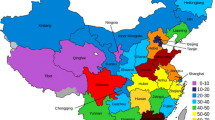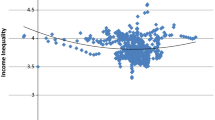Abstract
Focusing on Indonesia, this study analyzes the relationship between inequality and the process of urbanization. It performs a panel data regression analysis to test the Kuznets inverted-U hypothesis for urbanization based on a provincial panel data set of 33 provinces over the period 2000–2009, constructed by using the core National Socio-economic Survey (core Susenas). Our results support the Kuznets inverted-U hypothesis, whether the Gini coefficient or the Theil indices are used as a measure of inequality. According to our estimates, expenditure inequality would reach the peak at an urbanization rate of around 46–50 %. Since the 2010 urbanization rate is 50 %, this indicates that expenditure inequality has already attained the peak value. Thus, further urbanization would decrease expenditure inequality, but all other things being equal.


Similar content being viewed by others
Notes
For example, Ahluwaria (1976a, b), Knight and Sabot (1983), Saith (1983), Papanek and Kyn (1986), Campano and Salvatore (1988), Ram (1988, 1989, 1990), Anand and Kanbur (1993), Jha (1996), Deininger and Squire (1997, 1998), Matyas et al. (1998), De Gregorio and Lee (2002), Eastwood and Lipton (2004), Huang (2004), Frazer (2006) and Angeles (2010).
Angeles (2010) also employed the share of employment outside agriculture as an explanatory variable rather than the share of urban population; but, the result did not support the Kuznets hypothesis either.
It should be noted that a large part of urbanization in Indonesia is not due to internal migration, but due to urban sprawl, where rural areas are reclassified as urban areas.
It should be noted that expenditures are more equally distributed than incomes; thus, expenditure inequality tends to be smaller than income inequality. In a developing country like Indonesia, expenditure data are more reliable than income data (Akita et al. 1999).
We can obtain a similar decomposition equation based on the Theil \(L\) index.
In urban Yogyakarta, inequality due to educational differences is very large, accounting for more than 40 % of urban inequality, which is compared to 20 % in Jakarta.
Central Java registers a relatively low expenditure inequality among Java provinces, owing to its small urban-rural disparity.
References
Ahluwaria, M.S.: Inequality, poverty and development. J. Dev. Econ. 3(4), 307–342 (1976a)
Ahluwaria, M.S.: Income distribution and development: some stylized facts. Am. Econ. Rev. 66(2), 128–135 (1976b)
Akita, T., Lukman, R.A.: Spatial patterns of expenditure inequalities in Indonesia: 1987, 1990, and 1993. Bull. Indones. Econ. Stud. 35, 65–88 (1999)
Akita, T., Lukman, R.A., Yamada, Y.: Inequality in the distribution of household expenditures in Indonesia: a Theil decomposition analysis. Dev. Econ. 37(2), 197–221 (1999)
Akita, T., Miyata, S.: Urbanization, educational expansion, and expenditure inequality in Indonesia in 1996, 1999, and 2002. J. Asia Pac. Econ. 13, 147–167 (2008)
Akita, T., Alit, P.: Urban inequality in Indonesia. In: Handra, H., Resosudarmo, B.P., Yusuf, A.A., Elfindri and Yonnedi, E. (eds.) Regional Development and Finances: Challenges for Expanding and Financing Public Services. Andalas University Press, Padang (2012)
Anand, S.: Inequality and Poverty in Malaysia: Measurement and Decomposition. World Bank Research Publication, Oxford University Press, New York (1983)
Anand, S., Kanbur, S.M.R.: The Kuznets process and the inequality-development relationship. J. Dev. Econ. 40(1), 25–52 (1993)
Angeles, L.: An alternative test of Kuznets’ hypothesis. J. Econ. Inequal. 8(4), 463–473 (2010)
Asian Development Bank (ADB): Key Indicators for Asia and the Pacific 2013. Asian Development Bank, Philippines (2013)
Asra, A.: Poverty and inequality in Indonesia: estimates, decomposition and key issues. J. Asia Pac. Econ. 5, 91–111 (2000)
Cameron, L.: Growth with or without equity? The distributional impact of Indonesian development. Asian Pac. Econ. Lit. 16(2), 1–17 (2002)
Campano, F., Salvatore, D.: Economic development, income inequality and Kuznets’ U-shaped hypothesis. J. Policy Modeling 10(2), 265–280 (1988)
Central Bureau of Statistics (CBS): Core National Socio-economic Survey. Central Bureau of Statistics, Jakarta (various issues)
Central Bureau of Statistics (CBS): Gross Regional Domestic Product of Provinces in Indonesia by Industrial Origin. Central Bureau of, Statistics, Jakarta (various issues)
Cornwell, K., Anas, T.: Survey of recent developments. Bull. Indones. Econ. Stud. 49(1), 7–33 (2013)
Deininger, K., Squire, L.: Economic growth and income inequality: reexamining the links. Finance and Development, pp 38–41(1997)
Deininger, K., Squire, L.: New ways of looking at old issues: inequality and growth. J. Dev. Econ. 57(2), 259–287 (1998)
Eastwood, R., Lipton, M.: Rural and urban income inequality and poverty: does convergence between sectors offset divergence within them? In: Cornia, C.A. (ed.) Inequality, Growth, and Poverty in an Era of Liberalization and Globalization. Oxford University Press, Oxford (2004)
Fields, G.S.: Decomposing LDC inequality. Oxford Econ. Papers 31(3), 437–459 (1979)
Fields, G.S.: Distribution and Development. MIT Press, Cambridge (2001)
Frazer, G.: Inequality and development across and within countries. World Dev. 34(9), 1459–1481 (2006)
De Gregorio, J., Lee, J.W.: Education and income inequality: new evidence from cross-country data. Rev. Income Wealth 48(3), 395–416 (2002)
Huang, H.C.R.: A flexible nonlinear inference to the Kuznets hypothesis. Econ. Lett. 84, 289–296 (2004)
Jha, S.K.: The Kuznets curve: a reassessment. World Dev. 24(4), 773–780 (1996)
Knight, J.B.: Explaining income distribution in less developed countries: a framework and an agenda. Oxford Bull. Econ. Stat. 38(3), 161–177 (1976)
Knight, J.B., Sabot, R.H.: Educational expansion and the Kuznets effect. Am. Econ. Rev. 73(5), 1132–1136 (1983)
Kuznets, S.S.: Economic growth and income inequality. Am. Econ. Rev. 45(1), 1–28 (1955)
Leigh, A., van der Eng, P.: Inequality in Indonesia: what can we learn from top incomes? J. Public Econ. 93(1/2), 209–212 (2009)
Matyas, L., Konya, L., Macquarie, L.: The Kuznets U-curve hypothesis: some panel data evidence. Appl. Econ. Lett. 5(11), 693–697 (1998)
Nugraha, K., Lewis, P.: Towards a better measure of income inequality in Indonesia. Bull. Indones. Econ. Stud. 49(1), 103–112 (2013)
Papanek, G.F., Kyn, O.: The effect on income distribution of development, the growth rate and economic strategy. J. Dev. Econ. 23(1), 55–65 (1986)
Ram, R.: Economic development and income inequality: further evidence on the U-curve hypothesis. World Dev. 16(11), 1371–1376 (1988)
Ram, R.: Can educational expansion reduce income inequality in less-developed countries? Econ. Educ. Rev. 8(2), 185–195 (1989)
Ram, R.: Educational expansion and schooling inequality: international evidence and some implications. Rev. Econ. Stat. 72(2), 266–274 (1990)
Robinson, S.: A note on the U hypothesis relating income inequality and economic development. Am. Econ. Rev. 66(3), 437–440 (1976)
Saith, A.: Development and distribution: a critique of the cross-country U-hypothesis. J. Dev. Econ. 13(3), 367–382 (1983)
Shorrocks, A.: The class of additively decomposable inequality measures. Econometrica 48(3), 613–25 (1980)
Shorrocks, A., Wan, G.: Spatial decomposition of inequality. J. Econ. Geogr. 5(1), 59–81 (2005)
Skoufias, E.: Changes in regional inequality and social welfare in Indonesia from 1996 to 1999. J. Int. Dev. 13, 73–91 (2001)
Tadjoeddin, M.Z.: Miracle that never was: disaggregated level of inequality in Indonesia. Int. J. Dev. Issues 12(1), 22–35 (2013)
Tadjoeddin, M.Z., Suharyo, W.I., Mishra, S.: Regional disparity and vertical conflict in Indonesia. J. Asia Pac. Econ. 6, 283–304 (2003)
Author information
Authors and Affiliations
Corresponding author
Additional information
An earlier version of the paper was presented at the 23rd Pacific Conference of the Regional Science Association International in Bandung, Indonesia in July 2013. The authors would like to thank participants of the session on Poverty, Inequality and Inter-regional Disparity and two anonymous referees for their useful comments and suggestions. Takahiro Akita is grateful to the Japan Society for the Promotion of Science for its financial support (Grant-in-Aid for Scientific Research No. 24530274).
Rights and permissions
About this article
Cite this article
Sagala, P., Akita, T. & Yusuf, A.A. Urbanization and expenditure inequality in Indonesia: testing the Kuznets hypothesis with provincial panel data. Lett Spat Resour Sci 7, 133–147 (2014). https://doi.org/10.1007/s12076-013-0106-7
Received:
Accepted:
Published:
Issue Date:
DOI: https://doi.org/10.1007/s12076-013-0106-7




